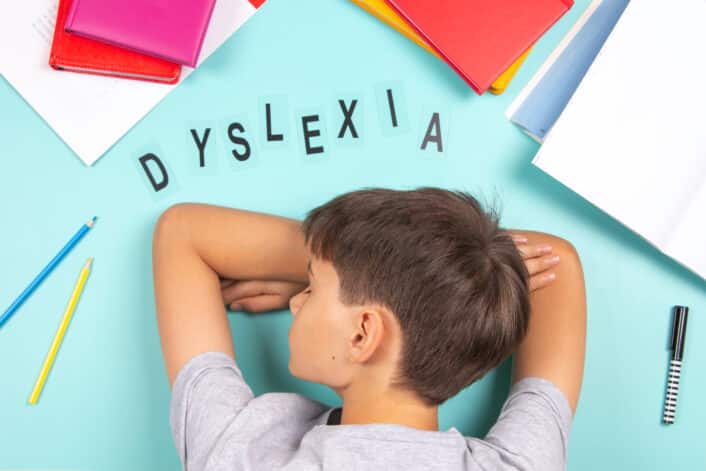

Disclaimer: This article is for informational purposes only and is not intended to diagnose any conditions. LifeDNA does not provide diagnostic services for any conditions mentioned in this or any other article.
For people with dyslexia, everyday reading tasks may feel like decoding a foreign language. It’s frustrating, especially when one’s effort doesn’t seem to match results. But the root cause isn’t a lack of will, it’s in how the brain interprets written language. Genetics is helping explain why some brains are simply built to learn and process information differently.
Affecting up to 10% of the population, dyslexia challenges traditional notions of learning because it’s not caused by a lack of effort or intelligence. Understanding these roots may help improve diagnosis and intervention.
Dyslexia is a specific learning difficulty that primarily affects reading, spelling, and writing. Individuals with dyslexia often struggle with decoding words, recognizing written symbols, and processing phonological information or the sounds of language. These difficulties may appear despite normal intelligence and access to education.
While reading challenges are the most visible symptoms, dyslexia may also affect working memory, rapid naming, and processing speed. It’s a lifelong condition, but with the right strategies and support, people with dyslexia can thrive academically and professionally.
You may want to read: How Genetics Shape Spatial Attention: A Deep Dive into Cognitive Abilities
Dyslexia affects people differently, but the following are some common symptoms:
You may want to read: Is Math ability Determined by Genetics?
The causes of dyslexia are multifactorial, meaning they stem from both genetic and environmental influences. While educational settings and early childhood experiences may shape how dyslexia manifests, research confirms that inherited factors play a major role in its development.
Genetic factors linked to dyslexia don’t just influence reading ability, they help shape how the brain develops in the first place. Research shows that the genes that are associated with dyslexia can affect areas in the brain that are important for recognizing sounds and connecting them to written words, especially on the brain’s left side.
Brain scans of people with dyslexia often show differences in specific regions involved in reading, such as the temporoparietal and occipitotemporal areas. These differences are tied to genes that guide how brain cells move and settle into place during development.
Genes such as DCDC2 and KIAA0319 help guide neurons to their proper places in the brain. When this process is disrupted, the brain’s reading circuits may not develop well. Imaging studies show that people with dyslexia often have weaker connections in key language brain pathways like the arcuate fasciculus. This may slow down how quickly the brain combines what it hears with what it sees, which is critical for reading smoothly.
While reading instruction and intervention programs may help boost reading skills, they don’t completely reverse these brain differences. This shows that genetic wiring has a long-lasting effect on how the brain processes language and reading, even when external support is provided.
T Twin studies provide some of the strongest evidence that dyslexia has a genetic component. Researchers often compare monozygotic (identical) twins, who share 100% of their genes, with dizygotic (fraternal) twins, who share about 50%.
When one identical twin has dyslexia, the other is much more likely to have it too, more often than in fraternal twin pairs. This higher concordance rate among identical twins suggests that genes play a major role in the development of dyslexia. Heritability estimates from these studies range between 40% and 70%, meaning that genetics accounts for a significant portion of the risk. However, the fact that concordance is not 100% even in identical twins also shows that environmental factors, such as early language exposure, teaching quality, and home literacy, also influence whether and how dyslexia develops. Twin research has helped us understand that dyslexia is not caused by a single gene but a combination of genetic and environmental factors.
A recent genome-wide association study (GWAS) investigated the genetic basis of dyslexia by analyzing data from over 51,800 adults who reported being diagnosed with dyslexia and more than one million individuals without the condition. Participants answered a survey question asking whether they had ever been diagnosed with dyslexia, allowing researchers to compare genetic differences between those who answered “yes” and those who answered “no.” The sample included both men and women, with the average age being around 50 years.
The study identified 42 genetic regions strongly linked to dyslexia, all meeting strict standards for statistical significance. Another 64 regions showed potential links, suggesting they may also be involved but need further study. These results support the idea that dyslexia is a polygenic trait influenced by a wide range of genes, not just a single one.
To see whether these genetic effects differed by age or sex, researchers analyzed subgroups. The results were remarkably consistent. Genetic similarity (max 1.0) was 0.91 between males and females, and 0.97 between younger and older adults. This means the genetic influence on dyslexia appears stable across age and sex, although more of the younger adults reported having dyslexia. About 5.3% of people in their twenties said they were affected, compared to just 3.2% of those in their eighties. This may reflect increased awareness, improved screening, or changes in how dyslexia is diagnosed over time.
There is no known cure for dyslexia, but effective management strategies may improve outcomes:


